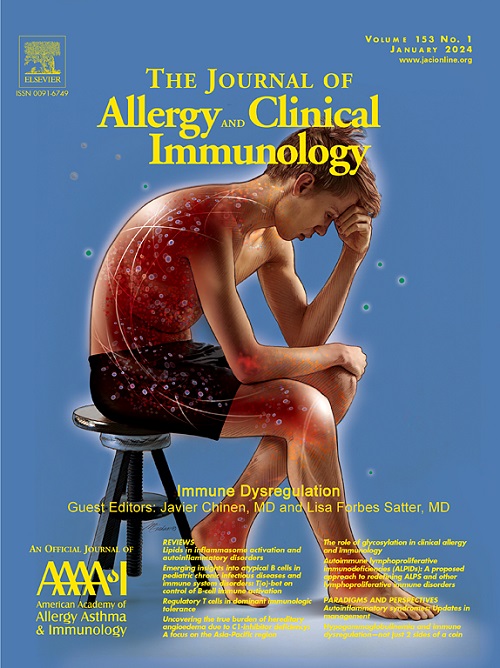Developmental trajectories of atopic dermatitis with multiomics approaches in the infant gut: COCOA birth cohort
IF 11.4
1区 医学
Q1 ALLERGY
引用次数: 0
Abstract
Background
An understanding of the phenotypes and endotypes of atopic dermatitis (AD) is essential for developing precision therapies. Recent studies have demonstrated evidence for the gut-skin axis in AD.
Objective
We sought to determine the natural course and clinical characteristics of AD phenotypes and investigate their mechanisms on the basis of multiomics analyses.
Methods
Latent class trajectory analysis was used to classify AD phenotypes in 2247 children who were followed until age 9 years from the COhort for Childhood Origin of Asthma and allergic diseases birth cohort study. Multiomics analyses (microbiome, metabolites, and gut epithelial cell transcriptome) using stool samples collected at age 6 months were performed to elucidate the underlying mechanisms of AD phenotypes.
Results
Five AD phenotypes were classified as follows: never/infrequent, early-onset transient, intermediate transient, late-onset, and early-onset persistent. Early-onset persistent and late-onset phenotypes showed increased risks of food allergy and wheezing treatment ever, with bronchial hyperresponsiveness evident only in the early-onset persistent phenotype. Multiomics analyses revealed a significantly lower relative abundance of Ruminococcus gnavus and a decreased gut acetate level in the early-onset persistent phenotype, with potential associations to ACSS2, Janus kinase–signal transducer and activator of transcription signaling, and systemic TH2 inflammation. The early-onset transient phenotype was associated with adenosine monophosphate-activated protein kinase (AMPK) and/or chemokine signaling regulation, whereas the late-onset phenotype was linked with IL-17 and barrier dysfunction.
Conclusions
Multiomics profiling in early life may offer insights into different mechanisms underlying AD phenotypes in children.

利用多组学方法研究婴儿肠道特应性皮炎的发展轨迹:COCOA 出生队列
背景:了解特应性皮炎(AD)的表型和内型对于开发精准疗法至关重要。最近的研究证明了肠道-皮肤轴在特应性皮炎中的作用:确定 AD 表型的自然病程和临床特征,并基于多组学分析研究其机制:方法:对哮喘和过敏性疾病儿童起源队列(COCOA)出生队列研究中随访至9岁的2247名儿童的AD表型进行潜类轨迹分析。研究人员利用6个月大时采集的粪便样本进行了多组学分析(微生物组、代谢物和肠道上皮细胞转录组),以阐明AD表型的潜在机制:结果:AD 表型分为以下五种:从未/不经常发病、早发一过性、中期一过性、晚发和早发持续性。早发性持续表型和晚发性表型显示食物过敏和喘息治疗的风险增加,支气管高反应性仅在早发性持续表型中明显。多组学分析表明,在早发性持续表型中,小反刍球菌(Ruminococcus gnavus)的相对丰度明显降低,肠道醋酸盐水平下降,这可能与 ACSS2、JAK-STAT 信号转导和全身 Th2 炎症有关。早发性瞬时表型与AMPK和/或趋化因子信号调节有关,而晚发性表型则与IL-17和屏障功能障碍有关:结论:生命早期的多组学分析可能有助于深入了解儿童注意力缺失症表型的不同机制。
本文章由计算机程序翻译,如有差异,请以英文原文为准。
求助全文
约1分钟内获得全文
求助全文
来源期刊
CiteScore
25.90
自引率
7.70%
发文量
1302
审稿时长
38 days
期刊介绍:
The Journal of Allergy and Clinical Immunology is a prestigious publication that features groundbreaking research in the fields of Allergy, Asthma, and Immunology. This influential journal publishes high-impact research papers that explore various topics, including asthma, food allergy, allergic rhinitis, atopic dermatitis, primary immune deficiencies, occupational and environmental allergy, and other allergic and immunologic diseases. The articles not only report on clinical trials and mechanistic studies but also provide insights into novel therapies, underlying mechanisms, and important discoveries that contribute to our understanding of these diseases. By sharing this valuable information, the journal aims to enhance the diagnosis and management of patients in the future.

 求助内容:
求助内容: 应助结果提醒方式:
应助结果提醒方式:


